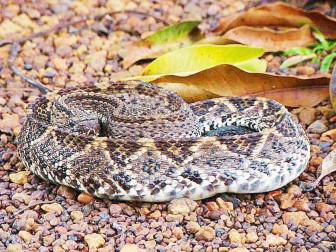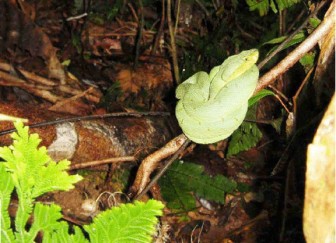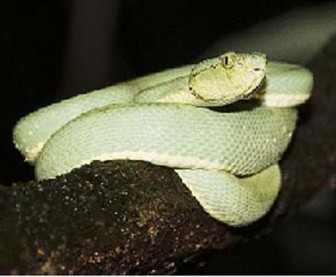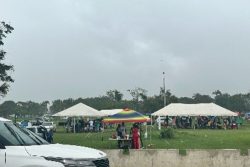The last of the well-known snake families found in Guyana is the Vipers (Viperidae). The other families were the Coloubrids, Elapids and Boas. The lesser known families are Aniliidae, Anomalepididae, Leptotyphlopidae and Typhlopidae. The known vipers of Guyana are the Carpet Labaria (Bothrops atrox) cousin to the Fer de Lance of Central America, the Guiana or Savannah Rattlesnake (Crotalus durissus), the Parrot Snake (Bothriopsis bilineata) and the dreaded Bushmaster (Lachesis muta). The checklist of reptiles of Guyana, however, records two species of Labaria and two species of Parrot Snake.
Vipers are known for their long, paired, hinged, hollow fangs. In biting the venom is injected from a venom gland located at the base of the upper jaw. When in rest the fangs are folded back against the roof of the mouth in a membranous sheath. Vipers mainly use their venom to immobilise and digest their prey. Its secondary use is for self defence. They are usually stockily built with keeled scales, a short tail and triangular shaped head due to the location of the venom glands. The eyes are vertically elliptical that can open across the whole eye or close completely. This trait allows vipers to see in a wide range of light levels. Vipers are usually nocturnal and use ambush to obtain their prey. Most vipers are ovoviviparous (birth live young) though some lay eggs.
The venom of a viper has a protease that will immobilize the prey and begin to breakdown the fat and protein tissues. This digestive component is an adaptation in vipers as their digestive system is very inefficient. The bites of vipers can be very painful and while in many cases the bite maybe a dry bite, it should always be taken seriously. Permanent scarring may occur at the bite site.
![]() The Bushmaster ranges in length from 2-3m; it is the longest venomous snake in the western hemisphere and the longest viper. The tail has a horny spine at the tip that it would vibrate like a rattler when disturbed. It is unique in the viper group in laying eggs. It is capable of multi-bite strikes and delivering large doses of venom.
The Bushmaster ranges in length from 2-3m; it is the longest venomous snake in the western hemisphere and the longest viper. The tail has a horny spine at the tip that it would vibrate like a rattler when disturbed. It is unique in the viper group in laying eggs. It is capable of multi-bite strikes and delivering large doses of venom.

The Parrot Snake can range in length from 0.70 to 1m. They are relatively slender with a prehensile tail. They are nocturnal, spending their time hiding in thick vegetation during the day but always where there is a place to anchor themselves with their tails.
The Guiana Rattlesnake has a neurotoxin in its venom that causes gradual paralysis. It has a preference for savannah type habitat and can range in lengths up to 1.8m.
Labaria are the most encountered of the vipers as they are the most numerous of the vipers and would move around in the day to hunt if necessary. The length can range up to 1.6 m; they are excellent swimmers and climbers. They breed year round and the female would move in and out of sunlight to keep her developing embryos at a constant temperature. The venom is a haemotoxin and is fast acting. It is said that in almost all cases there is temporary and sometimes permanent loss of local or short term memory when bitten by a Labaria.
Rain forests are rich in biodiversity and are home to many different plants and animals as well as indigenous communities.
Humans, even those who don’t live in the rain forest, rely on it for resources such as building materials (wood and lianas), medicine and fruits.

(Photo by the Rupununi
Learners Inc)
Rain forests also provide essential environmental services for life on earth; they create soil as well as prevent soil erosion, produce oxygen through photosynthesis, maintain clean water systems, and are a key defence against climate change.
The Iwokrama Rain Forest is 371,000 hectares, located in the heart of Guyana. Our mission is to develop strategies for conservation and sustainable development for local people in Guyana and the world at large.
We are involved in timber, tourism and training. Come and visit us in the rain forest or at http://www .iwokrama.org.










